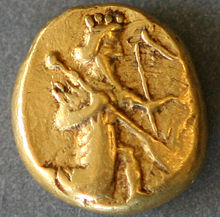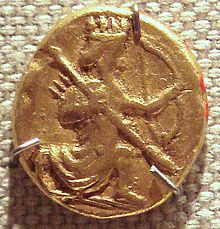- Persian daric
-
The daric was a gold coin used within the Persian Empire. It was of very high gold quality, with a purity of 95.83%.[1] Weighing around 8.4 grams, it bore the image of the Persian king or a great warrior armed with a bow and arrow, but who is depicted is not known for sure. The coin was introduced by Darius the Great of Persia some time between 522 BC and 486 BC and ended with Alexander the Great's invasion in 330 BC. Upon the invasion of Persia by Alexander they were melted down and recoined as coins of Alexander. This is believed to be the main reason for their rarity in spite of their widespread usage at the time.[2]
Close to the end of the 5th century BC, the Persian satraps in Asia Minor decided to strike their own coins. Darius considered such encroachment a crime punishable by death since the right of coinage was treated as an exclusively royal prerogative. The numismatic evidence does not permit identification of the image on the darics and sigloi as anything but that of the emperor; it was adopted by Darius as a dynamic expression of his royal power expressly for his coin issues.
The coin is mentioned several times in the Old Testament, as the Israelites came into contact with it when their Babylonian conquerors were conquered by Persia. The first Book of Chronicles describes king David as asking an assembly of people to donate for the construction of the Temple. The people gave generously "for the service of the house of God five thousand talents and ten thousand darics of gold, ten thousand talents of silver, eighteen thousand talents of bronze, and one hundred thousand talents of iron."[3] Since David's reign is believed to be between c. 1048 and c. 1007 B.C. according to Old Testament chronology, the use of the daric is either an anachronism or a conversion by the writer into contemporary units.[4][5]
In the ancient times, it was nicknamed "the archer". For instance, Agesilaus said that he had been driven out of Asia by thirty thousand archers, referring to the bribe distributed by the Persian King.[6]
There is also a double daric issued either by Darius III or Alexander around 350 BC- 330 BC but information on this is scarce.
Some, such as the Ancient Greeks, believed that this coin's name is derived from the name Darius, but in reality it appears to be derived from a Persian word meaning "gold"; in Middle Persian it is called zarig.
See also
- Achaemenid currency
References
- ^ Charles Anthon, L.L.D. (1841). A Classical Dictionary. New York: Harper & Brothers.
- ^ Charles Anthon, L.L.D. (1841). A Classical Dictionary. New York: Harper & Brothers.
- ^ 1 Chronicles 29:7 (New Revised Standard Version), emphasis added.
- ^ Ralph W. Klein (1993). "1 Chronicles". In Wayne A. Meeks (ed.). The HarperCollins Study Bible. New York, NY: HarperCollins. pp. 605–646. ISBN 0-06-065580-1.
- ^ John H. Walton; Victor H. Matthews and Mark W. Chavalas (2000). The IVP Bible Background Commentary: Old Testament. Downers Grove, IL: InterVarsity Press. ISBN 0-8308-1419-1.
- ^ Charles Anthon, L.L.D. (1841). A Classical Dictionary. New York: Harper & Brothers.
External links
Categories:- Ancient currencies
Wikimedia Foundation. 2010.


